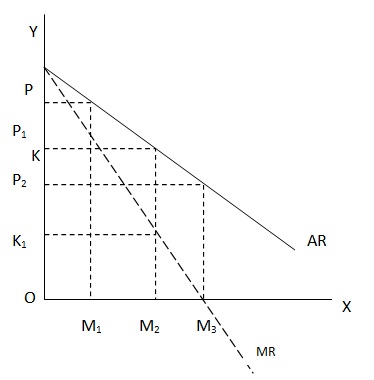Marginal Revenue is the change in TR which results from changing the output sold by one unit. At any level of a firm’s output, MR is the revenue it would add to TR if it sold another unit of its output or alternatively, the amount by which TR will fall if it sells one unit less. Algebraically, MRn = TRn – TRn -1, where ‘n’ is the number of units of the goods sold. This means, the marginal revenue from selling ‘n’ units (TRn) minus the TR earned by selling one unit less than ‘n’ unit, viz. (TRn – 1).
If the price per unit of the goods is fixed and constant, the increase in total revenue consequent to increase in one additional unit of the goods will be equal to its price. Price is the same as average revenue, and the addition to the total revenue made by one more unit sold is the marginal revenue, which in this case is equal to the price. Hence, MR = AR = P. therefore, the same AR curve, which is parallel to the horizontal axis, also shows the MR, as shown. But when price per unit falls with an increase in quantity sold and therefore AR is falling, the MR falls at a greater rate. This is clear. When AR falls from $ 10 to $ 9 by $2. With a similar $ 1 fall in AR from $9 to $8, MP falls by $2 from $ 8 to $ 6. And when quantity sold increases from 5 units to 6 units, AR goes down from $ 6 to $ 5, but MR goes down from $ 2 to $ 0. This means that the additional unit sold now does not make any addition to total revenue and therefore MR = 0. At this point firm’s total revenue is maximum. A further increase in quantity sold reduces the AR (P) in such a manner that total revenue becomes less than before and the MR becomes negative. The relationship between falling AR and MR curves.

When units of quantity sold are increased from OM1 to OM2, the AR falls by an amount equal to PP1, but the MR goes down by a much bigger amount equal to KK1. Similarly, a further increase in quantity sold form M2 to M3 reduces AR by P1 P2 but MR goes down (by K1 O) from OK1 to zero, which is the point where MR curve intersects the X-axis. Beyond this, AR is positive but MR is negative.
SUBMIT ASSIGNMENT NOW!